Variables and Functions
Today we are reviewing some of the basics to be sure everyone understands what we have been doing so far.
while loops
Let’s start with a basic Bit world:
from byubit import Bit
bit = Bit.new_world(5, 3)
bit.draw()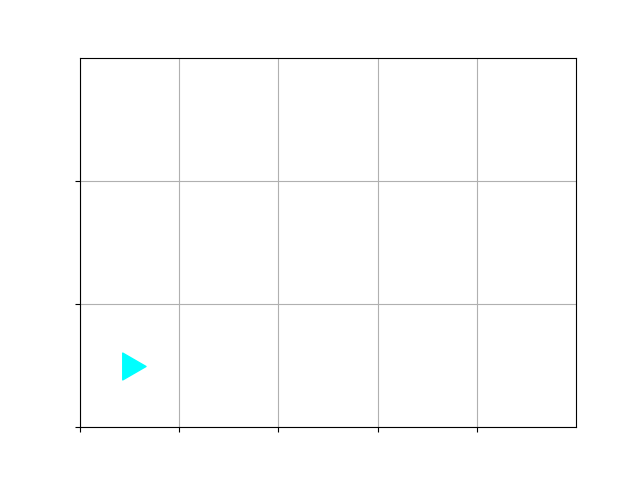
Post-condition for a while loop
If we want to paint the bottom row green, we can use the following:
while bit.front_clear():
bit.paint("green")
bit.move()
bit.draw()However, notice that we are missing the last block:
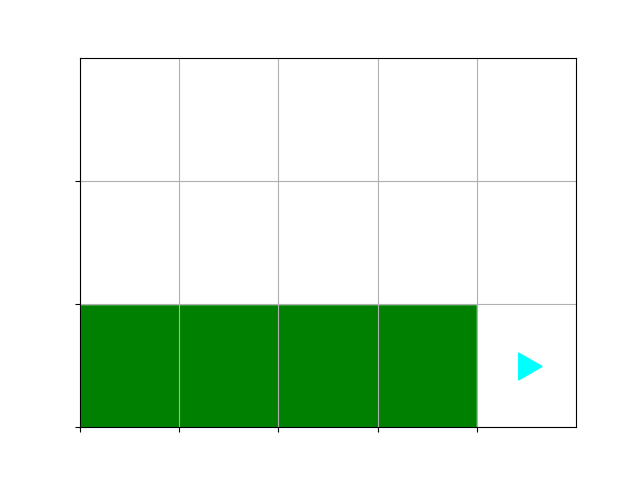
This is a great example of a post-condition. After the while loop ends, bit is sitting on the last square, and it is not painted. How do we paint the last square? Add an extra paint() after the while loop:
while bit.front_clear():
bit.paint("green")
bit.move()
bit.paint("green")
bit.draw()Pre-condition for a while loop
Likewise, if we swap the paint() and move() functions, we get this:
while bit.front_clear():
bit.move()
bit.paint("green")
bit.draw()Now, the first square is not painted. Think about the pre-condition for the while loop. Bit starts on an unpainted square. The first thing we do in the while loop is move to the next square. So to paint the first square, add an extra paint() before the while loop:
bit.paint("green")
while bit.front_clear():
bit.move()
bit.paint("green")
bit.draw()Variables
Let’s create a way to paint whatever color we want:
color = "blue"
while bit.front_clear():
bit.paint(color)
bit.move()
bit.paint(color)Play with this code in PyCharm. Notice how you can change the value of the
variable called color to be “green”, “red”, or “blue”, and it paints a
different color each time.
A variable has a name, a value, and a type. The name of this variable is “color”. The value of the variable is “green” (or whatever other color you choose). The type of the variable is “string” because it holds a string.
Let’s look at some other variable types:
name = "Sarah"
age = 23
load = 15.5
print(name)
print(age)
print(load)Sarah
23
15.5Here, the variable called “name” stores a string, the variable called “age” stores an integer, and the variable called “credits” stores a floating point number.
Adding
Let’s see what happens when we add 1 to each variable:
print(name + 1)We get a type error:
Traceback (most recent call last):
File "/Users/zappala/Documents/CS110/class/paint.py", line 19, in <module>
print(name + 1)
TypeError: can only concatenate str (not "int") to strWe can’t use the ”+” operator to add a string and an integer. But the others will work:
print(age + 1)
print(load + 1)24
16.1We can use the ”+” operator to add two or more strings:
first = "Sarah"
last = "Jones"
print(first + " " + last)Multiplying
Let’s try multiplying:
print(name*2)
print(age*2)
print(load*2)SarahSarah
46
31.0So we can also multiply strings. In fact, we can multiply them many times:
print(name*100)Sometimes we will call this “duck typing”. This term comes from the saying If it walks like a duck, and it quacks like a duck, then it must be a duck.
Basically, if an operation (such as multiplication) is defined for a given type, then it can be used for that type (such as multiplying strings).
Functions
Functions allow us to give a name to a set of statements. For example:
def happy():
print("I'm feeling happy")
happy()
happy()
happy()This defines a function called happy(), which just prints a simple statement.

Running this will get us:
I'm feeling happy
I'm feeling happy
I'm feeling happyParameters (or arguments)
We can also pass parameters to a function:
def say_how_i_am_feeling(feeling):
# I'm going to print how I'm feeling
print("I'm feeling")
# I get the feeling from a variable called feeling
print(feeling)
my_feeling = "quite impressed"
say_how_i_am_feeling(my_feeling)In this example, the variable my_feeling is set to a string, and then passed
as a parameter to the say_how_i_am_feeling() function. Inside this function,
the variable is called simply feeling.
We could do this in one step with:
say_how_i_am_feeling("quite impressed")In this case, the string “quite impressed” is stored in the variable feeling
once it is passed to the function.
In both cases, this will print:
I'm feeling
quite impressedString interpolation
Remember that we can use string interpolation to print all of this on one line, like this:
def say_how_i_am_feeling(feeling):
# I'm going to print how I'm feeling
print(f"I'm feeling {feeling}")
my_feeling = "quite impressed"
say_how_i_am_feeling(my_feeling)Notice that we use a single character, f at the start of the string, and then
we can put variables inside curly brackets, like {feeling}.
Docstrings, pre-conditions and post-conditions
When you write functions, you should always include a docstring, which is
surrounded by """. You can include the pre-conditions and post-conditions for
the function in this docstring. For example:
def say_how_i_am_feeling(feeling):
"""
This is a function that prints how someone is feeling.
Pre-condition: The variable feeling stores a string
Post-condition: The console shows a printed statement that says how I am feeling
"""
# I'm going to print how I am feeling
print(f"I'm feeling {feeling}")Bit and functions
Let’s take a look at the tree problem again. Put the following into a file
called tree.txt:
-------------
-ggggggggggg-
---ggggggg---
-------------
-------------
-------------
-------------
-------------
------r------
kkkkkkkkkkkkk
0 1
0The top part sets up the world for Bit (green is “g”, red is “r”, black is “k”), and the bottom part shows the position of Bit and its direction.
Let’s load the world:
from byubit import Bit
bit = Bit.load("tree.txt")
bit.draw()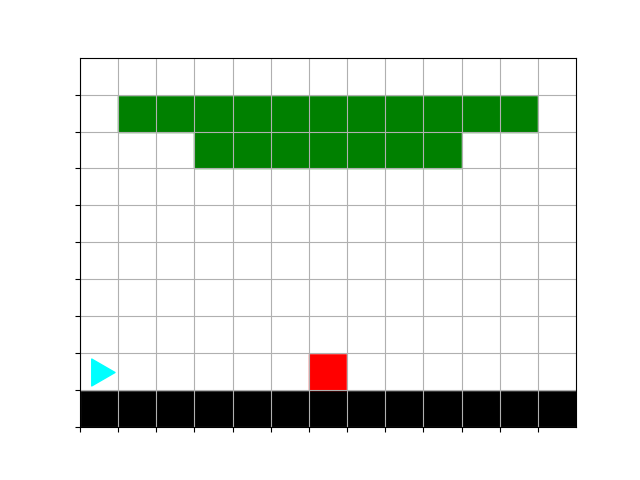
Variables that store a bit world
Let’s pause right here for a moment. What is bit in the code above? It’s a
variable! And it stores a bit world. In fact, it can be any name we want:
from byubit import Bit
world = Bit.load("tree.txt")
world.draw()Moving to the trunk
Let’s write a function that will move Bit until it reaches the bottom of the trunk:
from byubit import Bit
def move_to_trunk(bit):
""" Moves to the trunk, stopping at the first red square """
while bit.get_color() != "red":
bit.move()
world = Bit.load("tree.txt")
move_to_trunk(world)
world.draw()OK, this puts together a few things we have learned:
worldis a variable that holds the Bit world.- When we call
move_to_trunk(), we give itworld, and inside the function this is stored in a variable calledbit. - We can use a while loop to move to the bottom of the tree.
This gets us here:
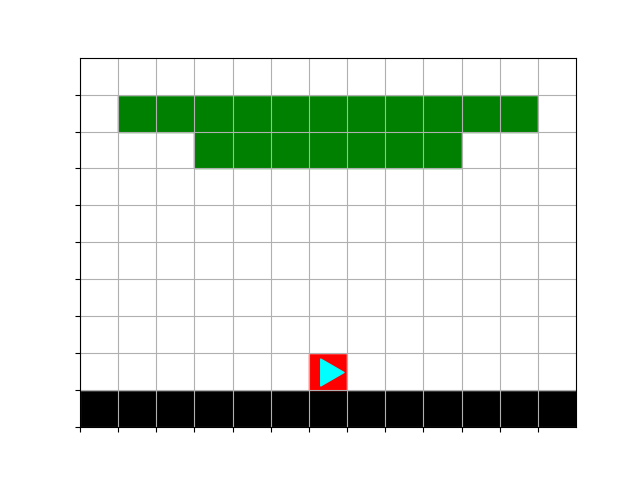
Revisiting variables
Remember that bit and world are just variables that hold a Bit world
(instead of a string or an integer). Put the following in a file called
mountain.txt:
--------r----
-------rrr---
------rrrrr--
kkkkkkkkkkkkk
0 1
0This world looks like this:
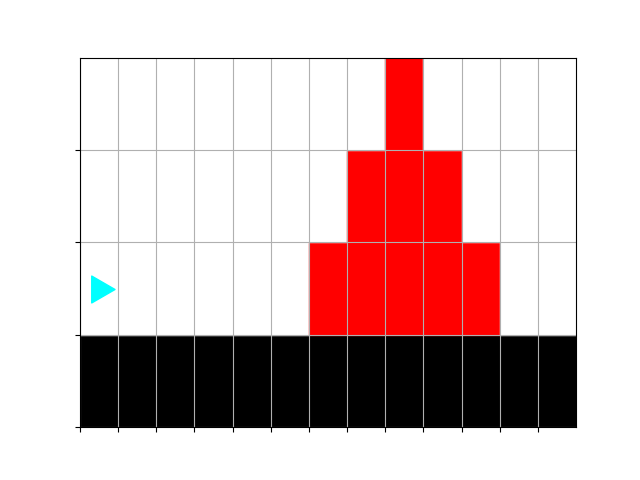
Now let’s try this:
from byubit import Bit
def move_to_trunk(bit):
""" Moves to the trunk, stopping at the first red square """
while bit.get_color() != "red":
bit.move()
world1 = Bit.load("tree.txt")
move_to_trunk(world1)
world1.draw()
world2 = Bit.load("mountain.txt")
move_to_trunk(world2)
world2.draw()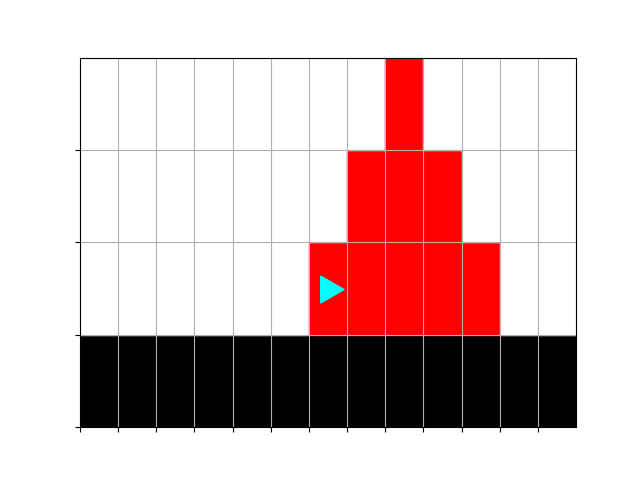
The same move_to_trunk() function works fine! This is because all it needs is
a bit world, and it doesn’t care if it is given the world1 variable or the
world2 variable.
Decomposition
Let’s finish with a little bit of decomposition. We already have a function that can move to the trunk. Let’s write another function that can draw the trunk:
def draw_trunk(bit):
""" Draws a trunk, stopping at the first green square. """
bit.left()
while bit.get_color() != "green":
bit.paint("red")
bit.move()We can combine these two:
from byubit import Bit
def move_to_trunk(bit):
""" Moves to the trunk, stopping at the first red square """
while bit.get_color() != "red":
bit.move()
def draw_trunk(bit):
bit.left()
while bit.get_color() != "green":
bit.paint("red")
bit.move()
world = Bit.load("tree.txt")
move_to_trunk(world)
draw_trunk(world)
world.draw()This gets us:
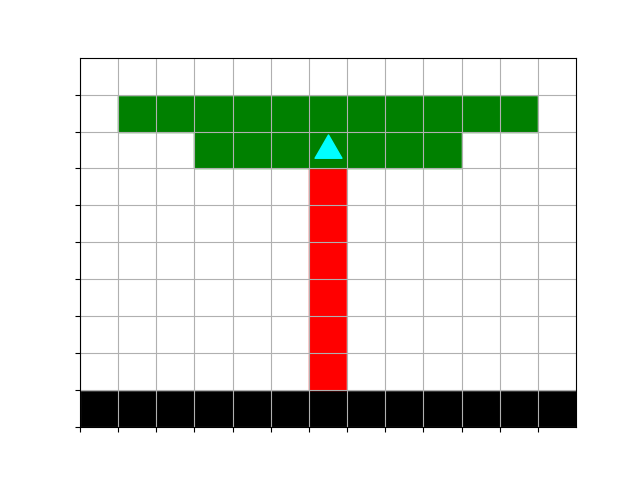
Multiple functions
And we can call functions from other functions! For example:
from byubit import Bit
def move_to_trunk(bit):
""" Moves to the trunk, stopping at the first red square """
while bit.get_color() != "red":
bit.move()
def draw_trunk(bit):
bit.left()
while bit.get_color() != "green":
bit.paint("red")
bit.move()
def fix_tree(bit):
move_to_trunk(bit)
bit.draw()
draw_trunk(bit)
bit.draw()
world = Bit.load("tree.txt")
fix_tree(world)More practice
Keep working on decomposition. For example, you might try the fix-the-forest
problem, using this file in forest.txt:
------------ggggggg------------
--ggggg------ggggg-------------
---ggg----g-----------ggggg----
---------ggg-------ggggggggggg-
----------g------------ggg-----
-------------------------------
-------------------------------
----r-----r----r--------r------
kkkkkkkkkkkkkkkkkkkkkkkkkkkkkkk
0 1
0You need:
- a function that goes back down the tree and stops just to the right of the trunk
- a function to fix all the trees